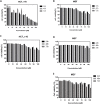Cytotoxic and apoptotic potential of gemini-chrysophanol nanoparticles against human colorectal cancer HCT-116 cell lines
- PMID: 35870982
- PMCID: PMC9308237
- DOI: 10.1186/s40360-022-00597-z
Cytotoxic and apoptotic potential of gemini-chrysophanol nanoparticles against human colorectal cancer HCT-116 cell lines
Abstract
Background: Colorectal cancer is among the most common cancers and accounts for nearly 9% of all cancers in the world. Chrysophanol is a naturally occurring anthraquinone exerts a number of pharmacological activities such as anti-inflammation, anti-cancer, anti-bacterial, anti-viral, and anti-oxidant effects. This study aims to produce a novel gemini chrysophanol nanoparticles (Gemini-Chr NPs), and to evaluate its anti-cancer effect on the human colorectal cancer cell lines.
Methods: Gemini-Chr NPs were synthesized through nanoprecipitation method and characterized by dynamic light scattering and scanning electron microscopy, Anti-cancer activities were examined through MTT assay on HCT-116 cancer cells, apoptosis was investigated via Annexin V-FITC/PI dual stain assay. Furthermore, the expression of Bax, Bcl-2 and P53 genes were evaluated using real-time PCR and western blotting assay. RESULTS: The average particle diameter of the synthesized Gemini-Chr NPs and zeta potential were recorded as 120 nm and 14.4 mV, respectively. In comparison to the normal cells, the cytotoxicity assay confirmed that Gemini-Chr NPs preferentially killed colorectal cancer cells via induction of apoptosis. Moreover, Gemini-Chr NPs could upregulate the expression of Bax in both cancerous and normal cells (p ≤ 0.05) and decreasing the Bcl-2 expression in only tumor cells (p ≤ 0.01), while the expression of P53 is modulated in tumor cells (p ≤ 0.05).
Conclusions: Gemini surfactants could be considered for efficient delivery and improvement of anti-cancer effect of chrysophanol. Gemini-Chr NPs might have the potential for developing novel therapeutic agent against colorectal cancer.
Keywords: Apoptosis; Bax/Bcl-2; Chrysophanol; Colorectal cancer; Gemini surfactant.
© 2022. The Author(s).
Conflict of interest statement
The author declares no conflict of interest.
Figures






Similar articles
-
Anti-proliferative and apoptotic effect of gemini curcumin in p53-wild type and p53-mutant colorectal cancer cell lines.Int J Pharm. 2021 May 15;601:120592. doi: 10.1016/j.ijpharm.2021.120592. Epub 2021 Apr 20. Int J Pharm. 2021. PMID: 33857585
-
Development of curcumin-loaded gemini surfactant nanoparticles: Synthesis, characterization and evaluation of anticancer activity against human breast cancer cell lines.Phytomedicine. 2019 Apr;57:183-190. doi: 10.1016/j.phymed.2018.11.017. Epub 2018 Nov 15. Phytomedicine. 2019. PMID: 30776589
-
Bio-Effects of TiO2 Nanoparticles on Human Colorectal Cancer and Umbilical Vein Endothelial Cell Lines.Asian Pac J Cancer Prev. 2018 Oct 26;19(10):2821-2829. doi: 10.22034/APJCP.2018.19.10.2821. Asian Pac J Cancer Prev. 2018. PMID: 30361551 Free PMC article.
-
Chrysophanol: A promising natural compound in cancer therapy - Mechanistic insights and future perspectives.Pharmacol Res. 2024 Dec;210:107502. doi: 10.1016/j.phrs.2024.107502. Epub 2024 Nov 7. Pharmacol Res. 2024. PMID: 39521026 Review.
-
Chrysophanol: A Natural Anthraquinone with Multifaceted Biotherapeutic Potential.Biomolecules. 2019 Feb 18;9(2):68. doi: 10.3390/biom9020068. Biomolecules. 2019. PMID: 30781696 Free PMC article. Review.
Cited by
-
NLRC4, inflammation and colorectal cancer (Review).Int J Oncol. 2024 Oct;65(4):99. doi: 10.3892/ijo.2024.5687. Epub 2024 Sep 6. Int J Oncol. 2024. PMID: 39239759 Free PMC article. Review.
References
-
- Kashiwada Y, Nonaka G-I, Nishioka I, Yamagishi T. Galloyl and hydroxycinnamoylglucoses from rhubarb. Phytochemistry. 1988;27:1473–1477. doi: 10.1016/0031-9422(88)80218-8. - DOI
-
- Tosun F, Akyüz KÇ. Anthraquinones and flavonoids from Rheum ribes. Ankara Univ Eczac Fak Derg. 2003;32:31–35. doi: 10.1501/Eczfak_0000000385. - DOI
MeSH terms
Substances
LinkOut - more resources
Full Text Sources
Medical
Research Materials
Miscellaneous

